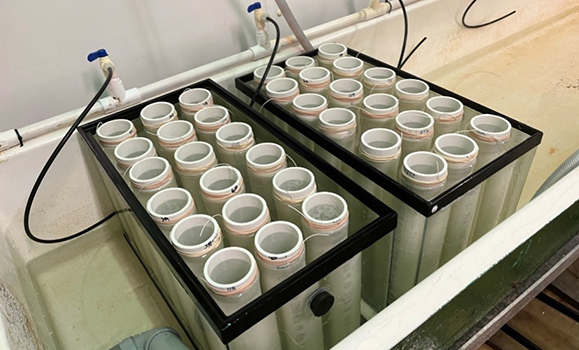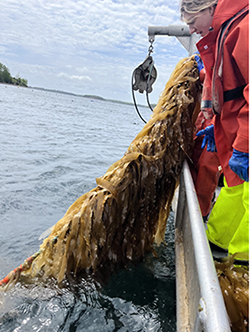Most seafood production in Canada comes from wild or natural stocks. However, Canadian aquaculture production has grown by over 140,000 tonnes since the early 1990s. Aquaculture involves the farming of aquatic species, including fish, shellfish, and marine plant species like kelp.
Aquaculture was initially used to supplement wild fish stocks but is now a large-scale industry, with the production value growing from $234 million in 1991 to $1.3 billion by 2021.
Researchers at Dalhousie University are utilizing the institution’s world-class research facilities to ensure aquaculture can be as sustainable and effective as possible.
The Aquatron, based at Dalhousie, is Canada’s largest university aquatic research facility. Celebrating its 50th anniversary in 2024, the facility is considered one of the best of its kind in the world.
Dr. Carolyn Buchwald, a chemical oceanographer with a focus on nutrient cycling, uses the facility and its staff to research kelp aquaculture. Her research, funded by the Ocean Frontier Institute’s Seed Fund program, is focused on better understanding the optimal conditions for kelp growth from seeds. “We want to help Nova Scotia kelp aquaculture industry grow, by better understanding one of the most cost intensive parts of the operation: the hatchery,” says Dr. Buchwald.

Kelp spools are shown in two tanks to allow kelp spores to settle on the string over a period of 24 hours. (Carly Buchwald photo)
From the Aquatron to the ocean
Kelp, or brown algae, can grow in many temperate and polar regions of the ocean. Lush kelp forests create habitats for diversity and are becoming an increasingly important food source globally.
To farm kelp in the ocean, it first must be grown on seeded lines, which are ropes containing baby kelp.
 Shown right: Dr. Buchwald’s team harvesting the kelp from the ocean. (Carly Buchwald photo)
Shown right: Dr. Buchwald’s team harvesting the kelp from the ocean. (Carly Buchwald photo)
Seeding the ropes takes place in a tank known as a hatchery over approximately six weeks. Dr. Buchwald and her team wanted to learn the most efficient way to conduct the process so they can advise kelp farmers on the best protocols for kelp seed production.
Dr. Buchwald partnered with the Ecology Action Centre (EAC) and Peter Darnell, the owner of Indian Point Marine Farms, to plant seeds grown under different conditions in the lab at Dalhousie at their test farm in Mahone Bay, Nova Scotia. The results will eventually enable the researchers to see which experiment treatment grew the best when returned to their natural environment.
A more time and cost-effective solution
Typically, farmers must spend a significant amount of time and money tending to kelp hatcheries. Dr. Buchwald’s research is aimed at making this process more time and cost effective.
Kelp farmers have three main controls to manipulate in their hatcheries: water sterilization; nutrients; and light. Dr. Buchwald and her team are researching how to adjust these variables to help kelp grow fastest and largest with an eye to supporting farmers in growing their crop more effectively.
Using water drawn in from the Atlantic off the coast of Halifax, the researchers are creating environments in the Aquatron’s lab facilities that approximate the conditions encountered by famers in the ocean, modifying sterilization levels and light accordingly. They are also testing nutrients, finding that tanks with lower nutrient levels had longer and more dense baby kelp growth. An encouraging discovery that Dr. Buchwald says should be pursued.
“I think there's still some research to be done on how to dial back [the nutrients] even more,” she says.
Facilitating growth
Dr. Buchwald notes that the Aquatron and its staff are essential to her project’s success, with the facility’s team advising on experimental set up and bringing the project to life with their guidance.
“The Aquatron staff are very involved with the projects going on in there and are super easy to work with,” says Buchwald.
She also notes that it plays a key role in helping to create a new generation of ocean researchers who can support science and industry in the province.
“We had 18 tanks and two undergraduate students working on this project,” she says, explaining that the experience is providing students with the relevant training and skills, should they wish to go into the kelp aquaculture sector and build the industry in Nova Scotia.

